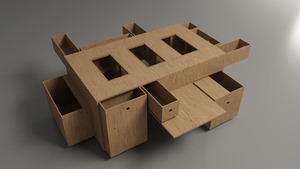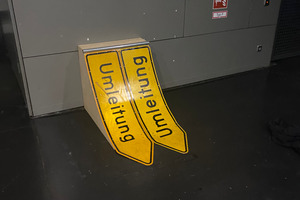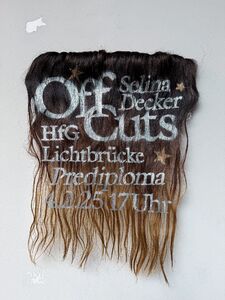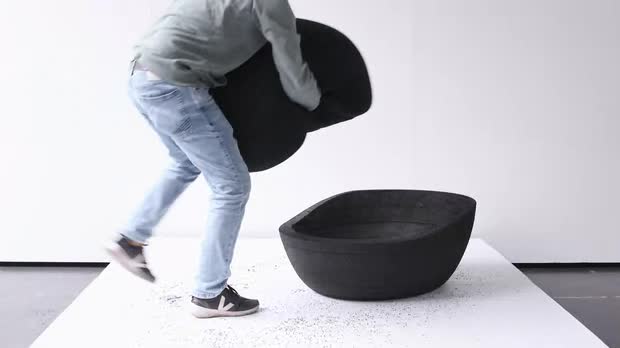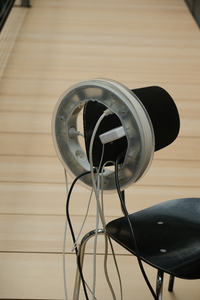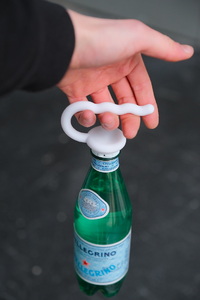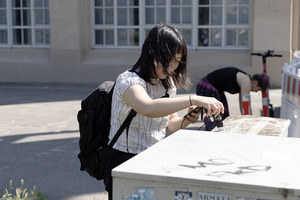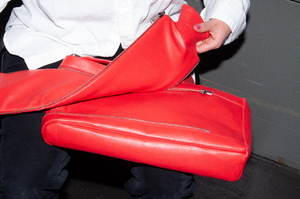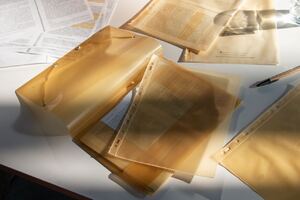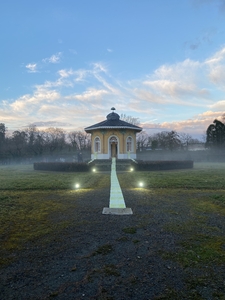weisse vernunft – siedlungsbau der 20er jahre
Benachbarte Sets (107)Alle Zusammenhänge anzeigen
Diese Sets wurden den gleichen Sets hinzugefügt wie das ausgewählte Set.
107 Inhalte
- Seite 1 von 9
Topologie des Verschwindens
- Titel
- Topologie des Verschwindens
- Autor/in
- Beschreibung (de)
- Am Anfang steht nicht die Form, sondern die Haltung. Genau das ist das bewusste und kritische Bewusstsein für den Raum. Was bedeutet es, wenn Architektur verschwindet? Was bleibt übrig, wenn das Nützliche, Sichtbare und Funktionale entfernt wird? Genau an diesem Punkt beginnt der eigentliche reflexive Handlungsspielraum des Künstlers. Anders gesagt: Es öffnet sich ein Denkraum, in dem nach den Bedingungen des Seins gefragt, die wesentlichen Strukturen der Dinge erprobt und noch nicht geformte Möglichkeiten konfrontiert werden. Denn jeder Akt der Entfernung ist ein Akt, der die Bedingungen für latente Bedeutung und Gestalt offenbart. So erscheint im Verschwinden etwas Neues.
In jeder Phase dieser Arbeit spiegelt sich ein bewusster und reflektierender Eingriff wider – eine Art choreografierter Dialog mit Struktur, Erinnerung und Bedeutung. Das Entfernen von Strukturen, das Imaginieren von Kästen, die Transformation des Innenhofs – all diese Eingriffe sind Akte der Erkenntnis und kritische Selbstbefragungen des Raums: „Was bin ich, wenn ich nicht mehr funktioniere?“ Dass Architektur ihre Funktion verliert, bedeutet, dass sie in einen Zustand des Schweigens gerät, in dem sie sich selbst nicht mehr erklären oder zeigen kann. Diese Fragen führen ganz natürlich zu einer weiteren: Wenn Architektur schweigt – wer bringt dann ihre innere Erinnerung und Struktur zum Sprechen?
Diese Arbeit basiert auf einer Annahme: Ein Tisch, der einst angefertigt, aber nie ausgestellt wurde, hat lange Zeit im Depot des Museums verbracht. Nun wird dieser Tisch in die Mitte des Ausstellungsraums gebracht – ein symbolischer Akt der Öffnung der in der Struktur versiegelten Erinnerung und des Wiedererscheinens einer verstummten Form. Die Form dieses Tisches verweist jedoch auf die Struktur des Gebäudes, in dem er sich befindet. Mit anderen Worten: Der Tisch ist ein Wesen, das die Erinnerung der Architektur, zu der er gehört, verinnerlicht hat. Indem er aus dem Ursprung geschaffen wurde und in diesen Ursprung zurückkehrt, rechtfertigt der Tisch seine Existenz als bedeutungstragende Entität im Raum.
Den Tisch in die Mitte zu stellen – als Vermittler und Übersetzer der Geschichte – ist keine zufällige Entscheidung. Es ist eine Metapher für die Rückkehr zur Oberfläche, zum Ausdruck, zur Geste der Öffnung. Innerhalb der Struktur, die er widerspiegelt, wird der Tisch zur Schnittstelle zwischen Betrachter und Struktur, zwischen Erinnerung und Gegenwart. Er fordert Handlung – doch jede Handlung ist der Beginn einer Interpretation, die eine potenzielle Erzählung liest, und jede Öffnung ist ein erbetener Dialog.
Wenn Architektur nicht mehr funktioniert, schweigt sie wie eine vergessene Sprache, deren Worte verstummt sind. Doch künstlerisches Eingreifen bringt dieses Schweigen wieder zum Sprechen. Diese Arbeit versteht Architektur als Sprache – eine vergessene, verschüttete, zum Schweigen gebrachte Sprache, die durch das Denken des Künstlers wieder sprechen lernt. Was hier gezeigt wird, ist ein materiell verdichteter Denkprozess. Es ist eine Erzählung, die sich durch Entfernung, Rekonstruktion und symbolische Neueinschreibung entfaltet.
In diesem Sinne ist die Arbeit selbst eine Topologie des Denkens über das Verschwinden – eine künstlerische, selbstreflexive Karte, die erforscht, wie Erinnerung und Struktur, Form und Bedeutung miteinander in Beziehung stehen, wie sie verteilt werden und wie sie wieder zu einer Erzählung verbunden werden. Jede Linie, die sie bildet, ist eine Handlung, und jede Handlung ist ein Satz im inneren Dialog der Form.
- Am Anfang steht nicht die Form, sondern die Haltung. Genau das ist das bewusste und kritische Bewusstsein für den Raum. Was bedeutet es, wenn Architektur verschwindet? Was bleibt übrig, wenn das Nützliche, Sichtbare und Funktionale entfernt wird? Genau an diesem Punkt beginnt der eigentliche reflexive Handlungsspielraum des Künstlers. Anders gesagt: Es öffnet sich ein Denkraum, in dem nach den Bedingungen des Seins gefragt, die wesentlichen Strukturen der Dinge erprobt und noch nicht geformte Möglichkeiten konfrontiert werden. Denn jeder Akt der Entfernung ist ein Akt, der die Bedingungen für latente Bedeutung und Gestalt offenbart. So erscheint im Verschwinden etwas Neues.
- Kategorie
- Typ des Projekts/Werks
- Datierung
- 23.07.2025
- Technik/Verfahren/Formate
- digitale Modellstudie
- Titel
- Topologie des Verschwindens
- Projektleiter/in
- Studiengang
- Importiert am
- 23.07.2025
- Übergeordnete Sets
- 0
- Set enthält
- 0 7
rethinking public space
- Titel
- rethinking public space
- Titel (en)
- rethinking public space
- Autor/in
- Beschreibung (de)
- „rethinking public space“ ist ein Projekt, das sich mit Street-Skating und Skate-Kultur befasst und untersucht, wie Skateboarder öffentliche Räume neudenken und umgestalten können.
Das Projekt besteht aus einer Publikation mit Fotos von Street-Skate-Spots und Interviews. Es enthält ein Interview mit der Stadt Stuttgart, über den Bau von Skateparks, DIY-Parks und Skate-Stoppern, und ein zweites Interview mit einem Skateboarder und Content Creator aus San Diego, der über die Skate-Kultur, ihre Beziehung zur Öffentlichkeit und die kreativen Wege spricht, mit denen Skateboarder Herausforderungen überwinden.
Die Publikation funktioniert wie ein Daumenkino, das alle Skate-Spots aus dem gleichen Blickwinkel zeigt und die Bewegung des Grindens durch sie hindurch nachahmt, unterbrochen nur durch Skate-Stopper-Seiten. Darauf folgen die Interviews.
Die Publikation ist in ein mit Wachs versiegeltes, siebgedrucktes Stoffband mit dem Namen der Publikation eingewickelt.
Weitere Wachsbänder, die jeweils einen Auszug aus einem der Interviews zeigen, sind über die gesamte Ausstellung verteilt.
Ein weiteres Element des Projekts auf Wachsbasis sind die Skatestopper-Wachsrepliken, die den Skatestoppern in Karlsruhe nachempfunden sind und das Skateboarden ermöglichen, anstatt es zu verhindern.
Begleitend zur Publikation gibt es eine Rampe aus alten Straßenschildern und Holzabfällen sowie eine Rail aus einem alten Rutschen-Seitenteil. Diese Elemente sind eine Hommage an DIY-Skate-Spots und nutzen kostengünstige, leicht verfügbare Ressourcen.
- „rethinking public space“ ist ein Projekt, das sich mit Street-Skating und Skate-Kultur befasst und untersucht, wie Skateboarder öffentliche Räume neudenken und umgestalten können.
- Beschreibung (en)
- 'rethinking public space' is a project focusing on street skating and skate culture, as well as exploring how skateboarders can reuse and reshape public spaces.
The project consists of a publication containing photographs of street skate spots and interviews. There is one interview with a city official talking about the process of building skate parks, DIY parks and skate stoppers, and a second interview with a skateboarder and content creator from San Diego talking about skate culture, its relationship with the public, and the creative ways skateboarders overcome obstacles.
The publication functions as a flipbook, showing all the skate spots from the same angle and emulating the motion of grinding through them, interrupted only by skate stopper pages. These are followed by the interviews.
The publication is wrapped in a wax-sealed, screen-printed cloth band bearing the publication's name.
More wax bands, each showcasing an excerpt from one of the interviews, are spread throughout the exhibition.
Another wax-based element of the project is the skatestopper wax replicas, modelled on those found in Karlsruhe, which enable skateboarding rather than prevent it.
Accompanying the publication is a ramp made from scrap street signs and discarded wood, as well as a rail made from an old slide side piece. These elements pay homage to DIY skate spots and utilise affordable, readily available resources.
- 'rethinking public space' is a project focusing on street skating and skate culture, as well as exploring how skateboarders can reuse and reshape public spaces.
- Kategorie
- Typ des Projekts/Werks
- Schlagworte
- Datierung
- 02.07.2025
- Dank an
- Sprache
- Material
- Technik/Verfahren/Formate
- Siebdruck, Lumbecken, Folienplott,
- Abmessungen
- Breite: 195mm, Höhe: 140mm
- Ort: Institution
- Ort
- Unter der Lichtbrücke
- Stadt
- Land
- Titel
- rethinking public space
- Projektleiter/in
- Semester
- Studiengang
- Typ der Abschlussarbeit
- Importiert am
- 21.07.2025
- Übergeordnete Sets
- 1
- Set enthält
- 3 0
OffCuts
- Titel
- OffCuts
- Autor/in
- Beschreibung (de)
- Ich habe menschliches Haar als Material und Textil erforscht. Haare sind etwas zutiefst Persönliches, aber auch eine weithin verfügbare und oft weggeworfene Ressource. Im Rahmen meiner Recherchen habe ich das Material aus verschiedenen Blickwinkeln - wissenschaftlich, kulturell und künstlerisch - untersucht und gleichzeitig mit ihm gearbeitet, um Textilien und Teppiche mit verschiedenen Techniken herzustellen.
- Beschreibung (en)
- I explored human hair as a material and textile. Hair is something deeply personal, yet it is also a widely available and often discarded resource. Through my research, I examined the material from different perspectives - scientific, cultural, and artistic, while also working hands-on with it to create textiles and carpets using various techniques.
- Kategorie
- Typ des Projekts/Werks
- Schlagworte
- Datierung
- 04.02.2025
- Mitwirkende
- Material
- Ort: Institution
- Titel
- OffCuts
- Projektleiter/in
- Semester
- Studiengang
- Typ der Abschlussarbeit
- Importiert am
- 21.07.2025
- Übergeordnete Sets
- 1
- Set enthält
- 0 7
Float
- Titel
- Float
- Titel (en)
- Float
- Autor/in
- Beschreibung (de)
- Der Float Lounger, entworfen von Felix Reif und Finn de Bruyn, hebt den Sitzsack auf das Niveau eines vollwertigen Relaxmöbels.
Sowohl die Basis als auch das Kissen bestehen aus expandiertem Polypropylen. Der Einsatz dieses innovativen Materials, das in der Möbelproduktion nur selten verwendet wird, ermöglicht einen leichten, robusten und zu 100 % recycelbaren Sitz. Das mit expandierten Polypropylen-Perlen gefüllte Kissen passt sich jeder Körperform an, steigert die Entspannung und vermittelt dabei das Gefühl, an einem Sonntagabend in einem Schaumbad zu versinken.
- Der Float Lounger, entworfen von Felix Reif und Finn de Bruyn, hebt den Sitzsack auf das Niveau eines vollwertigen Relaxmöbels.
- Beschreibung (en)
- The Float lounger, designed by Felix Reif and Finn de Bruyn, elevates the bean bag to the level of a full-fledged piece of relaxation furniture.
The base and cushion are made of expanded polypropylene. The use of this innovative material, which is rarely found in furniture production, allows for a lightweight, resilient, and 100% recyclable seat. The cushion, filled with expanded polypropylene beads, adapts to every body shape enhancing relaxation while creating the sensation of sinking into a bubble bath on a Sunday evening.
- The Float lounger, designed by Felix Reif and Finn de Bruyn, elevates the bean bag to the level of a full-fledged piece of relaxation furniture.
- Kategorie
- Typ des Projekts/Werks
- Datierung
- 02.2025
- Mitwirkende
- Dank an
- Material
- Titel
- Float
- Importiert am
- 21.07.2025
- Übergeordnete Sets
- 1
- Set enthält
- 0 7
Stromkreis
- Titel
- Stromkreis
- Titel (en)
- cirquit
- Autor/in
- Beschreibung (de)
- Die kreisförmige Mehrfachsteckdose gibt einem oft unbeachteten
Alltagsobjekt eine Stimme.
Der Kreis steht dabei sinnbildlich für Ordnung, Übersicht und Bewegung.
Anders als klassische Steckleisten, die sich in Ecken drängen lassen,
behauptet dieses Objekt seine Präsenz –
es verweigert das Verstecktsein und fühlt sich im Zentrum des Raums am
wohlsten.
Durch die mehrdirektionale Anordnung lassen sich Geräte aus allen
Richtungen mit Strom versorgen – eine Auflösung der linearen Nutzung
zugunsten räumlicher Offenheit.
Bis zu sieben Meter Kabel, die außen aufgewickelt werden, ermöglichen eine
flexible Nutzung in unterschiedlichsten Raumsituationen.
Die transparente Gestaltung der Seitenteile aus Plexiglas fördert ein neues
Bewusstsein für das Objekt – sie macht Funktion sichtbar und
Haltung greifbar.
So wird aus einem technischen Alltagsgegenstand ein
flexibler Begleiter, der sichtbar, nutzbar und verständlich
im Raum existiert.
- Die kreisförmige Mehrfachsteckdose gibt einem oft unbeachteten
- Beschreibung (en)
- The circular multiplug gives a voice to an often unnoticed everyday object. Here the circle symbolizes order, overview and movement. Unlike classic power strips, which can be pushed into corners, this object asserts its presence - it refuses to be hidden and feels most comfortable in the center of the room. The multi-directional arrangement allows devices to be supplied with power from all directions - a dissolution of linear use in favour of spatial openness. Up to seven meters of cable, which are wound up on the outside, enable flexible use in a wide variety of room situations. The transparent design of the Plexiglas side panels promotes a new awareness of the object - it makes function visible and attitude tangible. This turns an everyday technical object into a flexible companion that is visible, usable and understandable in the room.
- Kategorie
- Typ des Projekts/Werks
- Datierung
- 22.07.2025
- Titel
- Stromkreis
- Projektleiter/in
- Studiengang
- Importiert am
- 18.07.2025
- Übergeordnete Sets
- 1
- Set enthält
- 0 9
KLOTZSTUHL
- Titel
- KLOTZSTUHL
- Autor/in
- Beschreibung (de)
- Eine Studie des Stadtforschers William H. Whyte zeigt, dass es für Menschen ein positives Erlebnis ist, wenn sie Sitzmöbel selbst (um)positionieren dürfen. Der KLOTZSTUHL greift diesen Gedanken auf. Die Sitzfläche lässt sich verstellen, sodass sich der Stuhl an unterschiedliche Hangneigungen anpassen kann. Dadurch kann man ihn fast überall auf dem Hügel aufstellen. Er ist nicht fest installiert, aber durch seine "klotzige" Bauweise und das relative hohe Gewicht ist er auch nicht zum Mitnehmen gedacht.
Der KLOTZSTUHL wurde entworfen für Hänge in Parkanlagen wie beispielsweise dem MOUNT KLOTZ in der Günther-Klotz-Anlage in Karlsruhe. Er macht es möglich, auch an steilen Hängen bequem zu sitzen und die Aussicht auf den Sonnenuntergang mit einem kühlen Getränk zu genießen.
- Eine Studie des Stadtforschers William H. Whyte zeigt, dass es für Menschen ein positives Erlebnis ist, wenn sie Sitzmöbel selbst (um)positionieren dürfen. Der KLOTZSTUHL greift diesen Gedanken auf. Die Sitzfläche lässt sich verstellen, sodass sich der Stuhl an unterschiedliche Hangneigungen anpassen kann. Dadurch kann man ihn fast überall auf dem Hügel aufstellen. Er ist nicht fest installiert, aber durch seine "klotzige" Bauweise und das relative hohe Gewicht ist er auch nicht zum Mitnehmen gedacht.
- Beschreibung (en)
- A study by urban researcher William H. Whyte shows that people have a more positive experience in public spaces when they are allowed to (re)position seating furniture themselves. The KLOTZSTUHL embraces this idea. Its adjustable seat allows it to adapt to various slope angles, making it usable almost anywhere on a steep slope. It is not fixed in place, but due to its bulky design and quite heavy weight, it is also not meant to be carried away.
The KLOTZSTUHL was designed specifically for sloped areas in public parks, such as the MOUNT KLOTZ in the Günther-Klotz-Anlage in Karlsruhe. It makes it possible to sit comfortably even on steep hills, and to enjoy the view of the sunset with a cold drink.
- A study by urban researcher William H. Whyte shows that people have a more positive experience in public spaces when they are allowed to (re)position seating furniture themselves. The KLOTZSTUHL embraces this idea. Its adjustable seat allows it to adapt to various slope angles, making it usable almost anywhere on a steep slope. It is not fixed in place, but due to its bulky design and quite heavy weight, it is also not meant to be carried away.
- Titel
- KLOTZSTUHL
- Projektleiter/in
- Studiengang
- Importiert am
- 18.07.2025
- Übergeordnete Sets
- 1
- Set enthält
- 0 3
Anima Sola
- Titel
- Anima Sola
- Titel (en)
- Anima Sola
- Autor/in
- Beschreibung (de)
- Ein Fahrradschloss das leuchtet ist nicht nur eine naheliegende Zusammenlegung zweier Objekte die sich unter dem Sattel in die Quere kommen, sondern verhindert zur gleichen Zeit den Diebstahl akkubetriebener Rücklichter.
- Beschreibung (en)
- A bike lock that lights up is not only an obvious combination of two objects that contest the space under the saddle, but also prevents the theft of battery-powered rear lights at the same time.
- Typ des Projekts/Werks
- Schlagworte
- Datierung
- 18.07.2024
- Titel
- Anima Sola
- Projektleiter/in
- Studiengang
- Importiert am
- 18.07.2025
- Übergeordnete Sets
- 1
- Set enthält
- 0 8
PCO 1810
- Titel
- PCO 1810
- Titel (en)
- PCO 1810
- Autor/in
- Beschreibung (de)
- Der neu geformte Flaschendeckel fordert auf, eine Plastikflasche zu adoptieren und sie zur persönlichen Begleiterin im Alltag zu machen.
Seine Form ermöglicht es, die Flasche auf viele Weisen körpernah zu tragen und in die Umgebung einzubinden.
So wird die Flasche zur persönlichen, was dazu einlädt sie nach dem Leeren nicht wegzuwerfen, sondern immer wieder aufzufüllen.
Die ständige Verfügbarkeit von Wasser fördert ganz nebenbei einen erhöhten Wasserkonsum.
Dank des standardisierten PCO-Gewindes ist bei Bedarf ein flexibler Wechsel zu einer neuen Flasche jederzeit möglich.
- Der neu geformte Flaschendeckel fordert auf, eine Plastikflasche zu adoptieren und sie zur persönlichen Begleiterin im Alltag zu machen.
- Beschreibung (en)
- The newly shaped bottle lid invites you to adopt a plastic bottle and make it your personal companion in everyday life.
It's shape makes it possible to carry the bottle close to the body and integrate it into your environment creatively.
In this way, the bottle becomes personal, inviting you not to throw it away after emptying it, but to refill it again and again.
The constant availability of water also encourages increased water consumption.
Thanks to the standardized PCO thread, a flexible change to a new bottle is possible at any time if required.
- The newly shaped bottle lid invites you to adopt a plastic bottle and make it your personal companion in everyday life.
- Typ des Projekts/Werks
- Schlagworte
- Datierung
- 18.02.2025
- Titel
- PCO 1810
- Projektleiter/in
- Studiengang
- Importiert am
- 17.07.2025
- Übergeordnete Sets
- 1
- Set enthält
- 0 11
FROM ENLIGHTENMENT TO ENLICHENMENT
- Titel
- FROM ENLIGHTENMENT TO ENLICHENMENT
- Titel (en)
- FROM ENLIGHTENMENT TO ENLICHENMENT
- Untertitel
- Flechten, Symbiose und posthumanistische Perspektiven in Kunst und Theorie
- Untertitel des Projekts/Werks (en)
- Lichens, symbiosis and posthumanist perspectives in art and theory
- Autor/in
- Beschreibung (de)
- Die Aufklärung („Enlightenment“) stellte den Menschen ins Zentrum des Denkens – doch Flechten („Lichen“) lehren uns eine andere Art der Weltwahrnehmung: relational, vernetzt, nicht-menschlich-zentriert. Als symbiotische Verbindungen von Pilzen und Algen oder Cyanobakterien verkörpern sie ein Denken jenseits des Individuellen: Sie sind mehr-als-menschliche Organismen, Holobionten, Netzwerke aus Kooperation und Anpassung. Sie gedeihen in extremen Umgebungen, überdauern Jahrhunderte und bilden fragile Ökologien,
die oft übersehen werden – und doch fundamentale Lektionen für unser eigenes Dasein bereithalten. Dieses transdisziplinäre Seminar bewegt sich zwischen Wissenschaft, Philosophie und Medienkunst. Eine Exkursion mit Lichenolog*innen macht uns mit der stillen, aber
hochkomplexen Existenz der Flechten vertraut. Meditative Audiowalks laden dazu ein, das Netzwerk dieser Lebensformen zu dokumentieren und sich mit ihrer Zeitlichkeit und Materialität zu verbinden. Durch das Lesen zentraler Texte von Lynn Margulis, Scott Gilbert, Donna Haraway und Anna Tsing hinterfragen wir Konzepte von Autonomie, Subjektivität und multispeziesalem Zusammenleben. Schließlich werden wir in einem Workshop das gesammelte Wissen in Medienkunstwerke überführen – als spekulative Antworten auf die ökologischen und philosophischen Herausforderungen unserer Zeit.
- Die Aufklärung („Enlightenment“) stellte den Menschen ins Zentrum des Denkens – doch Flechten („Lichen“) lehren uns eine andere Art der Weltwahrnehmung: relational, vernetzt, nicht-menschlich-zentriert. Als symbiotische Verbindungen von Pilzen und Algen oder Cyanobakterien verkörpern sie ein Denken jenseits des Individuellen: Sie sind mehr-als-menschliche Organismen, Holobionten, Netzwerke aus Kooperation und Anpassung. Sie gedeihen in extremen Umgebungen, überdauern Jahrhunderte und bilden fragile Ökologien,
- Beschreibung (en)
- The Enlightenment placed humans at the centre of thought – but
lichens teach us a different way of perceiving the world: relational, interconnected,
non-human-centred. As symbiotic combinations of fungi and algae or cyanobacteria, they embody a way of thinking beyond the individual: they are more-than-human organisms, holobionts, networks of cooperation and adaptation. They
thrive in extreme environments, survive for centuries and form fragile ecologies
that are often overlooked – yet hold fundamental lessons for our own existence
.
This transdisciplinary seminar moves between science, philosophy and
media art. An excursion with lichenologists familiarises us with the quiet but
highly complex existence of lichens. Meditative audio walks invite us to document the
network of these life forms and connect with their temporality and
materiality. By reading key texts by Lynn Margulis, Scott Gilbert,
Donna Haraway and Anna Tsing, we question concepts of autonomy, subjectivity and
multispecies coexistence. Finally, in a workshop, we will transform the
knowledge we have gathered into media artworks – as speculative responses to the
ecological and philosophical challenges of our time.
- The Enlightenment placed humans at the centre of thought – but
- Kategorie
- Typ des Projekts/Werks
- Schlagworte
- Datierung
- Juni 2025
- Mitwirkende
- Dank an
- Sprache
- Ort: Institution
- Ort
- Bio Design Lab
- Stadt
- Land
- Titel
- FROM ENLIGHTENMENT TO ENLICHENMENT
- Importiert am
- 17.07.2025
- Übergeordnete Sets
- 1
- Set enthält
- 0 21
Honey
- Titel
- Honey
- Titel (en)
- Honey
- Untertitel
- hotbag
- Untertitel des Projekts/Werks (en)
- hotbag
- Autor/in
- Beschreibung (de)
- Wie können wir Wärme mobilisieren? Diese Handtasche mit integrierter Wärmflasche ist eine Antwort auf diese Frage. Sie wurde speziell entwickelt, um Menstruationsbeschwerden zu lindern, ohne diese natürlichen Bedürfnisse zu verbergen oder zu tabuisieren. Stattdessen setzt sie ein sichtbares und selbstbewusstes Statement, das zeigt: Wohlbefinden verdient Aufmerksamkeit und Designlösungen, bei denen weibliche Designerinnen eine zentrale Rolle im heutigen gesellschaftlichen Diskurs spielen. Die Tasche ist so konzipiert, dass sie Komfort auf Reisen bietet, beispielsweise bei der Arbeit oder in öffentlichen Räumen.
Die extra lange Wärmflasche für Bauch und Rücken speichert die Wärme stundenlang und lässt sich leicht wieder auffüllen. Ein modulares Reißverschlusssystem sorgt für Vielseitigkeit in der Anwendung, und eine thermische Einlage schützt vor Überhitzung im Inneren der Tasche.
- Wie können wir Wärme mobilisieren? Diese Handtasche mit integrierter Wärmflasche ist eine Antwort auf diese Frage. Sie wurde speziell entwickelt, um Menstruationsbeschwerden zu lindern, ohne diese natürlichen Bedürfnisse zu verbergen oder zu tabuisieren. Stattdessen setzt sie ein sichtbares und selbstbewusstes Statement, das zeigt: Wohlbefinden verdient Aufmerksamkeit und Designlösungen, bei denen weibliche Designerinnen eine zentrale Rolle im heutigen gesellschaftlichen Diskurs spielen. Die Tasche ist so konzipiert, dass sie Komfort auf Reisen bietet, beispielsweise bei der Arbeit oder in öffentlichen Räumen.
- Beschreibung (en)
- How can we mobilise heat? This handbag with an integrated hot water bottle is an answer to this question. It is specially designed to relieve menstrual pain without hiding or tabooing these natural needs. Instead, it makes a visible and confident statement that shows: Well-being deserves attention and design solutions, where female designers play a central role in today's social discourse. The bag is designed to provide comfort when travelling, for example at work or in public spaces.
The extra-long hot water bottle for for stomach and back retains heat for hours and can be filled up again easily. A modular zip system ensures versatility of use, and a thermal inlay protects against overheating inside the bag.
- How can we mobilise heat? This handbag with an integrated hot water bottle is an answer to this question. It is specially designed to relieve menstrual pain without hiding or tabooing these natural needs. Instead, it makes a visible and confident statement that shows: Well-being deserves attention and design solutions, where female designers play a central role in today's social discourse. The bag is designed to provide comfort when travelling, for example at work or in public spaces.
- Kategorie
- Typ des Projekts/Werks
- Schlagworte
- Datierung
- Februar 2025
- Material
- Technik/Verfahren/Formate
- textile Handarbeit
- Ort: Institution
- Ort
- Lichtbrücke
- Stadt
- Land
- Titel
- Honey
- Importiert am
- 17.07.2025
- Übergeordnete Sets
- 1
- Set enthält
- 0 9
ChitoTinkering
- Titel
- ChitoTinkering
- Titel (en)
- ChitoTinkering
- Untertitel
- neue perspektiven für chitosan
- Untertitel des Projekts/Werks (en)
- new perspectives for chitosan
- Autor/in
- Beschreibung (de)
- Im Rahmen ihres Materialforschungsprojekts entwickelten Benjamin Kaltenbach, Lilith Stumpf, Felix Harr und Julia Ihls innovative Anwendungen für Chitosan – ein vielseitiges Biopolymer, das aus Chitin gewonnen wird. Chitin ist nach Cellulose das zweithäufigste natürliche Polymer und bildet die strukturelle Basis für die Schalen von Krebstieren, die Exoskelette von Insekten sowie Zellwände bestimmter Pilze.
Inspiriert von der schützenden Funktion von Chitin in der Natur übertrugen die Designer*innen die Materialeigenschaften von Chitosan in einen alltagsnahen Kontext. Der Fokus lag dabei auf den Konzepten von Gehäusen und Hüllen – Anwendungen, die Schutz und Struktur vereinen. Das Ergebnis sind eine Reihe funktionaler Prototypen, darunter ein Lampenschirm, ein Stift, transparente Dokumentenhüllen sowie eine Dokumentenmappe, die aus dem Chitosan-Komposit gefertigt wurden.
Um die gestalterischen und technischen Möglichkeiten des Materials auszuloten, wurden unterschiedliche Bearbeitungstechniken erprobt: Das Chitosan-Material wurde genäht, genietet, gebügelt, gefaltet, selbstverklebt sowie mittels CNC-Laser graviert und geschnitten. Diese experimentelle Auseinandersetzung mit Verarbeitungstechniken hebt die gestalterische Vielseitigkeit von Chitosan hervor und zeigt sein Potenzial als nachhaltige Material Alternative auf.
Durch diese gestalterische und technische sowie konzeptuelle Auseinandersetzung eröffnen die Designer*innen neue Perspektiven für Chitosan und unterstreichen sein Potenzial als nachhaltige Material Alternative.
- Im Rahmen ihres Materialforschungsprojekts entwickelten Benjamin Kaltenbach, Lilith Stumpf, Felix Harr und Julia Ihls innovative Anwendungen für Chitosan – ein vielseitiges Biopolymer, das aus Chitin gewonnen wird. Chitin ist nach Cellulose das zweithäufigste natürliche Polymer und bildet die strukturelle Basis für die Schalen von Krebstieren, die Exoskelette von Insekten sowie Zellwände bestimmter Pilze.
- Beschreibung (en)
- As part of their material research project, Benjamin Kaltenbach, Lilith Stumpf, Felix Harr, and Julia Ihls developed innovative applications for chitosan – a versatile biopolymer derived from chitin. Chitin is the second most abundant natural polymer after cellulose and forms the structural basis of crustacean shells, insect exoskeletons, and the cell walls of certain fungi.
Inspired by chitin’s protective function in nature, the designers translated the material properties of chitosan into everyday applications. Their focus was on the concept of enclosures and casings – objects that combine protection and structure. The result is a series of functional prototypes, including a lampshade, a pen, transparent document sleeves, and a folder, all made from chitosan composite material.
To explore the material’s creative and technical potential, various processing techniques were tested: The chitosan material was sewn, riveted, ironed, folded, self-adhered, and engraved or cut using a CNC laser. This experimental approach highlights the versatility of chitosan and demonstrates its potential as a sustainable material alternative.
Through this design and technical exploration, the designers open up new perspectives for chitosan and emphasize its potential as an innovative, bio-based material.
- As part of their material research project, Benjamin Kaltenbach, Lilith Stumpf, Felix Harr, and Julia Ihls developed innovative applications for chitosan – a versatile biopolymer derived from chitin. Chitin is the second most abundant natural polymer after cellulose and forms the structural basis of crustacean shells, insect exoskeletons, and the cell walls of certain fungi.
- Kategorie
- Typ des Projekts/Werks
- Schlagworte
- Datierung
- Februar 2025
- Mitwirkende
- Dank an
- Material
- Ort: Institution
- Ort
- Unter dem Bio Design Lab
- Stadt
- Land
- Internetlinks
- Titel
- ChitoTinkering
- Importiert am
- 17.07.2025
- Übergeordnete Sets
- 1
- Set enthält
- 0 9
Herkules & Karl
- Titel
- Herkules & Karl
- Titel (en)
- Herkules & Karl
- Autor/in
- Beschreibung (de)
- Die Statue „Herkules Farnese“ war sowohl in der Antike als auch während der Renaissance und des Barock eine der bekanntesten Ikonen. Der eigentlich unbesiegbare Held stützt sich erschöpft auf seine Keule und versteckt hinter seinem Rücken fast kindlich drei goldene Früchte. Laut der mythologischen Erzählung steht Herkules zu diesem Zeitpunkt kurz vor dem Ende der ihm auferlegten Aufgabenreihe, die ihm seinen rechtmäßigen Platz im Olymp verspricht. Die goldenen Früchte aus der Erzählung symbolisieren Fruchtbarkeit, Unsterblichkeit und Macht. Ursprünglich wurden sie als Äpfel interpretiert, sobald Zitrusfrüchte auf den europäischen Markt kamen, wurden aus ihnen Zitronen, Pomeranzen oder Orangen.
Mit dem stilisierten Aufleben der griechischen Antike zur Zeit der Renaissance gewann auch der „Herkules Farnese“ stärker an Bedeutung und wurde von vielen Adligen in ihren neu errichteten Gartenanlagen erst im Stil italienischer und später im Barock im Stil französischer Gärten verarbeitet sowie reproduziert. Orangerien, die zu den meisten barocken Gärten gehörten, wurden als Sammlungs- und Ausstellungsort der erworbenen Gewächse erbaut. August der Starke lies sich beispielsweise auf dem Dach seiner Orangerie als Herkules, der das Himmelsgewölbe trägt, darstellen.
Die barocken Gärten zeichnen sich besonders dadurch aus, dass die Architektur des Schloss oder Palast immer gemeinsam mit der künstlichen Landschaft entworfen wird. In Karlsruhe wurde allerdings nicht nur die Parkanlage im Gedanken des Absolutismus passend als Fortführung des Schloss gebaut, sondern auch durch die Stadtgründung 1715 die gesamte Stadtplanung dieser Ideologie folgend angelegt. Das Schloss und auch die langen Alleen, die Blickachsen auf das historische Machtzentrum erzeugen, existieren heute noch. Der Garten ist, wie fast alle anderen Anlagen im französischen Stil, relativ zügig nach der Erbauung in einen englischen Landschaftsgarten umgeplant worden.
Die Spuren der ursprüngliche Anlage sind in der Linolschnittserie mit einem Motiv basierend auf einem Bepflanzungsplan des Karlsruher Barockgartens sichtbar und ziehen die Besucher:innen der Installation von einer Metallplatte, die über die historischen Zusammenhänge der Arbeit aufklärt, in das Teehaus, den letzten Überrest des Barockgartens. Im Inneren des Pavillons steht eine Gedenkstätte für Karl, Barockgärten und die vergangenen Zeit, für die diese Männer zu Symbolfiguren wurden.
- Die Statue „Herkules Farnese“ war sowohl in der Antike als auch während der Renaissance und des Barock eine der bekanntesten Ikonen. Der eigentlich unbesiegbare Held stützt sich erschöpft auf seine Keule und versteckt hinter seinem Rücken fast kindlich drei goldene Früchte. Laut der mythologischen Erzählung steht Herkules zu diesem Zeitpunkt kurz vor dem Ende der ihm auferlegten Aufgabenreihe, die ihm seinen rechtmäßigen Platz im Olymp verspricht. Die goldenen Früchte aus der Erzählung symbolisieren Fruchtbarkeit, Unsterblichkeit und Macht. Ursprünglich wurden sie als Äpfel interpretiert, sobald Zitrusfrüchte auf den europäischen Markt kamen, wurden aus ihnen Zitronen, Pomeranzen oder Orangen.
- Beschreibung (en)
-
The ‘Hercules Farnese’ statue was one of the most famous icons in antiquity as well as during the Renaissance and Baroque periods. The actually invincible hero leans exhaustedly on his club and hides three golden fruits behind his back in an almost childlike manner. According to the mythological tale, at this point Hercules is about to complete the series of tasks imposed on him, which promises him his rightful place in Olympus. The golden fruits in the story symbolise fertility, immortality and power. Originally they were interpreted as apples, but as soon as citrus fruits came onto the European market, they became lemons, bitter orange or oranges.
With the stylised revival of Greek antiquity during the Renaissance, the ‘Hercules Farnese’ also became more important and was used and reproduced by many aristocrats in their newly built gardens, first in the style of Italian gardens and later in the Baroque period in the style of French gardens. Orangeries, which were part of most Baroque gardens, were built as a place to collect and display the plants acquired. Augustus the Strong, for example, had himself depicted on the roof of his orangery as Hercules carrying the vault of heaven.
Baroque gardens are particularly characterised by the fact that the architecture of the castle or palace is always designed together with the artificial landscape. In Karlsruhe, however, not only was the park built in the spirit of absolutism as a continuation of the palace, but the entire urban planning was also designed in line with this ideology when the city was founded in 1715. The palace and the long avenues, which create lines of sight to the historic centre of power, still exist today. Like almost all other French-style gardens, the garden was converted into an English landscape garden relatively quickly after its construction.
The traces of the original layout are visible in the linocut series with a motif based on a planting plan of the Karlsruhe Baroque garden and draw visitors to the installation from a metal plate, which explains the historical context of the work, into the tea house, the last remnant of the Baroque garden. Inside the pavilion is a memorial to Karl, baroque gardens and the bygone era for which these men became symbolic figures.
-
- Kategorie
- Typ des Projekts/Werks
- Schlagworte
- Datierung
- 25.02.2025 - 27.02.2025
- Mitwirkende
- Dank an
- Sprache
- Material
- Technik/Verfahren/Formate
- Linolschnitt, Lasergravur, audio-visuelle Installation, Animation, fiktionalisierte Geschichte
- Dauer
- ca 5min (Video)
- Ort
- Teehaus im Schlosspark
- Stadt
- Land
- Titel
- Herkules & Karl
- Studiengang
- Importiert am
- 17.07.2025
- Übergeordnete Sets
- 1
- Set enthält
- 0 12
